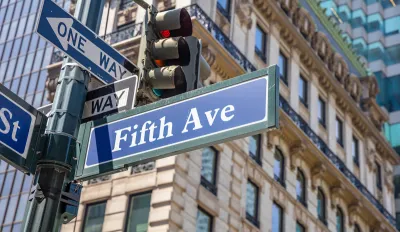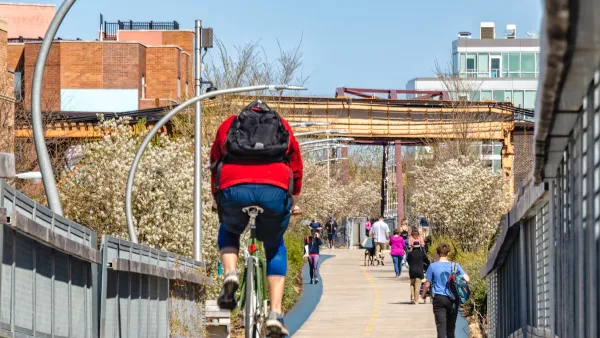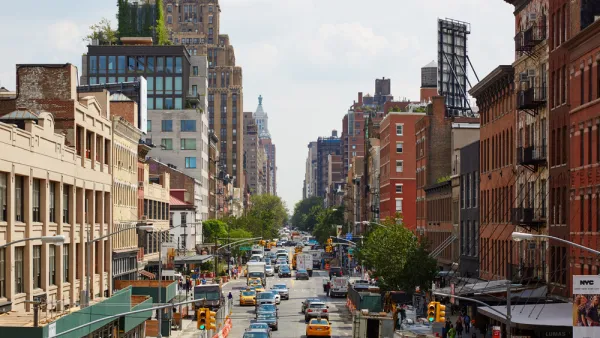Visitors to the iconic shopping street overwhelmingly arrive by walking, transit, or bike. Why are bike and pedestrian infrastructure improvement lagging so far behind another famous NYC street, Broadway?

Writing in Streetsblog NYC, Barak Friedman, Paul Krikler, and Janet Liff compare the adaptations of two iconic New York City streets to 21st century conditions: “while Broadway continues to transform into a world class destination, becoming more pedestrian and bike friendly, Fifth Avenue struggles.”
While Broadway is becoming increasingly pedestrianized and bike-friendly, Fifth Avenue languishes as e-commerce and commercial real estate vacancies leave the fabled shopping street emptier and emptier. According to the authors, former Mayor Bill de Blasio’s devision to nix a ‘compelte street’ plan for Fifth Avenue in 2021 “is sabotaging business interests and hurting the larger midtown post-pandemic recovery.”
A recent survey shows that crowded sidewalks make visitors to Fifth Avenue less likely to linger and shop. The same survey reveals that “Of the 226 people surveyed on Fifth Avenue, only 3 percent of people (seven people total) reached Fifth Avenue by using a private car or ride share. Some 97 percent of people walked, used public transit, or cycled.” And “Almost 70 percent of respondents indicated that they would be “more inclined” to cycle on Fifth Avenue with the addition of a protected bike lane.”
The authors conclude that in this case, more than others, “the interests of safety activists, the interests of business stakeholders, and the greater benefit to New York City are aligned.” Improved bike and pedestrian infrastructure on Fifth Avenue would benefit visitors, businesses, and Midtown Manhattan as a whole.
FULL STORY: Two Paths Forward: Broadway Shows What Could Be on Fifth Avenue

National Parks Layoffs Will Cause Communities to Lose Billions
Thousands of essential park workers were laid off this week, just before the busy spring break season.

Retro-silient?: America’s First “Eco-burb,” The Woodlands Turns 50
A master-planned community north of Houston offers lessons on green infrastructure and resilient design, but falls short of its founder’s lofty affordability and walkability goals.

Delivering for America Plan Will Downgrade Mail Service in at Least 49.5 Percent of Zip Codes
Republican and Democrat lawmakers criticize the plan for its disproportionate negative impact on rural communities.

Test News Post 1
This is a summary

Test News Headline 46
Test for the image on the front page.

Balancing Bombs and Butterflies: How the National Guard Protects a Rare Species
The National Guard at Fort Indiantown Gap uses GIS technology and land management strategies to balance military training with conservation efforts, ensuring the survival of the rare eastern regal fritillary butterfly.
Urban Design for Planners 1: Software Tools
This six-course series explores essential urban design concepts using open source software and equips planners with the tools they need to participate fully in the urban design process.
Planning for Universal Design
Learn the tools for implementing Universal Design in planning regulations.
EMC Planning Group, Inc.
Planetizen
Planetizen
Mpact (formerly Rail~Volution)
Great Falls Development Authority, Inc.
HUDs Office of Policy Development and Research
NYU Wagner Graduate School of Public Service





























